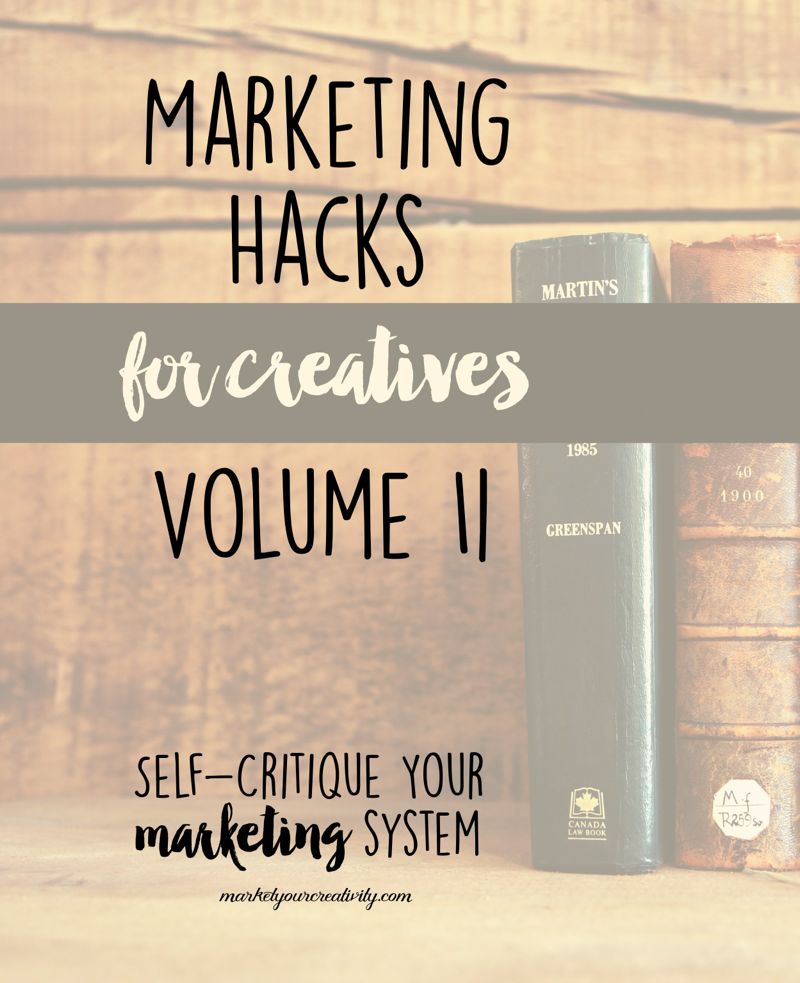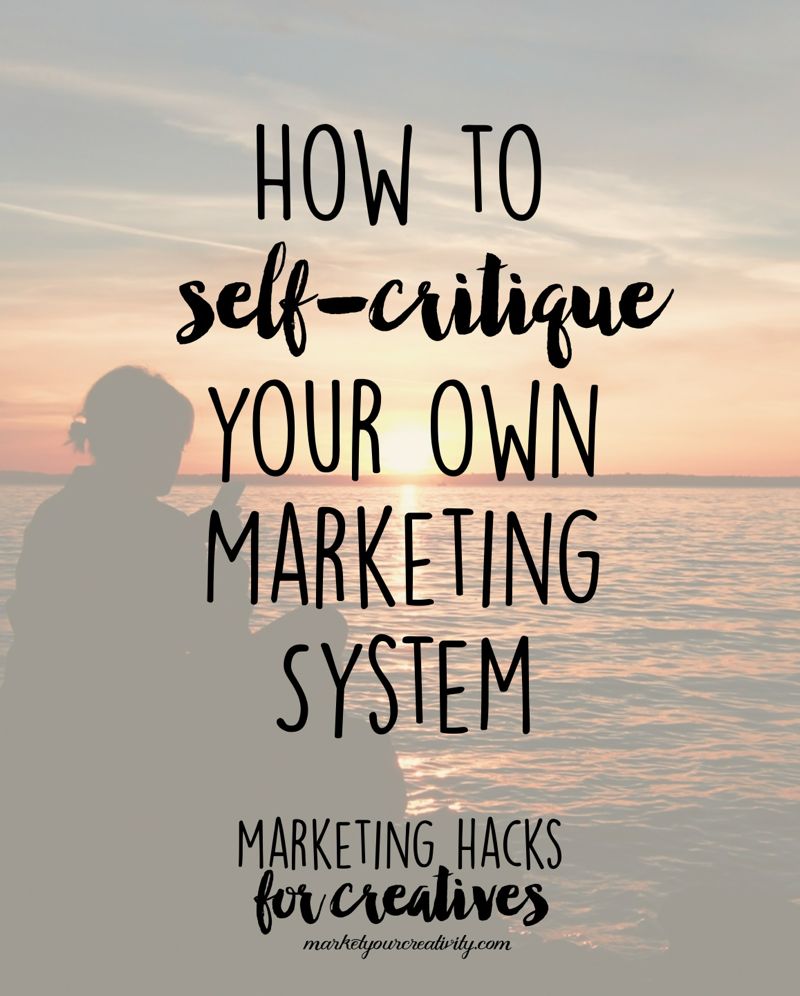Hello, lovely creative! Welcome to a new and ongoing series on Marketing Creativity: Marketing Hacks for Creatives (coming to you in volumes), building off the post, The Ultimate Guide to Marketing for Creatives. In case you’re just joining me, it’s best to start there for a complete picture of all that we’re going to cover.
I know some creatives don’t necessarily love the idea of marketing (or selling), but I gush over it. I spend a lot of time sharing that passion with my premium clients (aka The Luminaries), but I don’t write about it often enough. Therefore, I’m excited to show you a more in-depth look into my consulting through this series + offer a new way to look at marketing for your business.
Marketing Hacks for Creatives is inspired by the creative business course I’m leading inside of The Luminaries Club, where I can help you clarify and simplify an automated system for your business. Here’s a quick recap to what we’ve covered so far …
Marketing is a semi-automated system that you create for your business. There are six questions you must answer and six tasks you must complete to make your marketing system an effective one.
In Volume II of Marketing Hacks for Creatives, I’m going to show you how to self-critique your current marketing system so that you can identify where it’s lacking and needs improving.
Step 1: The Customer’s Approach
This set of six questions is considered from the customer’s perspective. Most of these ask you to put yourself in the customer’s shoes, and you’ll want to perform this part of the self-critique by thinking about what they want (not what you think they need) from your product.
#1 Who is the perfect customer for my product?
There are two things in business that I don’t give specific guidance on, and those are: your schedule and your ideal customer. These two topics are actually quite customized to suit you, and I don’t like to generalize the process by trying to guide everyone to a generic conclusion.
In the beginning, creating an ideal customer is a lot of guesswork, but the profile gets more real and useful over time. Rather than telling you what to do, I offer several exercises to help you create your own.
If you don’t have a detailed perfect customer in mind, you need one. Here’s a picture of mine. You simply cannot craft an effective marketing system without this profile.
#2 How do people typically find products like mine?
Sometimes we get so comfortable in our niche that we forget what it was like NOT to know everything there is to know about it. We start to build a marketing system from the level we’re on versus the level where we started (where our customers are likely hanging out).
Therefore, imagine you know nothing more than the most basic information about your product: you know what it is and that you want to find it.
It’s very interesting how we, as consumers, search for a new product online. Depending on what you’re searching for, you probably go straight to one of the following sites to find out more: Etsy, Amazon, Ebay, Pinterest, Google, etc. But the point is, you go directly and with a specific intention to find a certain product.
The question is: Where would an interested customer start if they were looking for your product? It seems like a basic question, but it’s filled with hidden insight and useful information. I have clients that sell the most amazing aprons on Etsy, in addition to their own website. When I was exploring their marketing system, I told them I have gone straight to Amazon to shop for product like theirs.
We go to Etsy when we’re looking for a unique touch, Amazon when we’re looking for a lot of choices and something we might not find in a regular store, Ebay when we’re looking for the best deal, Pinterest when we’re looking for examples of style, and Google when it’s a specific or uncommon product we don’t know much about. All considered, are you focusing on the right marketplace for your product?
#3 What’s in it for them?
What you think your customer needs and what your customer actually wants are often two very different things. Moreover, I catch most creative businesses being more concerned about what they want to sell than they are interested in what the customers wants to buy.
Listen to this advice from Scientific Advertising written by Claude Hopkins in the 1920’s:
“Remember the people you address are selfish, as we all are. They care nothing about your interests or your profit. They seek service for themselves. Ignoring this fact is a common mistake and a costly mistake in advertising. Ads say in effect, ‘Buy my brand. Give me the trade you give to others. Let me have the money.’ This is not a popular appeal.”
You want to home in on what it is you have to offer your ideal customer. When you’re able to think of your customer’s needs: whether you fill a void in their life by offering information or inspiration, make their house feel more special by creating home decor they love and adore, or make them feel more complete and confident by giving them that one special accessory for their outfit – whatever it is, there’s a purpose for your product in the customer’s life, and it’s your job to clearly identify it.
#4 What makes me the best person for the job?
A lot of people in our industry get caught up in the comparison game and feel threatened by competition. That’s why a little time and care spent on this question can go a long way. Identifying WHY you’re the best person to serve your specific ideal customer is the antidote to scarcity thought and insecurities.
Again, imagine that ideal customer from question #1. What makes you the best person for them to buy from? That then becomes your tagline, and should be incorporated into your about page and listings (where applicable).
#5 What makes your customer want to buy?
I could live here all day. I LOVE looking at what makes customers buy, what makes ME buy, and WHY we make those decisions when we do. #marketingnerd
Too often, amateur creative business owners feel entitled to sales simply because they listed a product online. There’s so much more to business than that! If it were easy, everyone would be working from home creating products they love.
Disappointment is a real danger in creative, passion-based businesses. It will cause you to drop a project when it doesn’t get off the ground as you’d expect. You forget that it’s not only your job to create that product, it’s also your job to help it find success.
This involves some advanced strategy that I’m currently teaching inside The Luminaries Club, but here’s a great place to start: 5 Surprising Reasons Customers Aren’t Buying (and what to do about it).
#6 How will you WOW them?
Many creative entrepreneurs see a customer’s first sale as a one-off deal, but to me, it’s the beginning of a beautiful relationship that I will treasure for years to come.
You are the expert in your field. The customer came to you because you have knowledge and talent that they appreciate. That means your shop is full of items that they want. Own your expertise, and be each customer’s personal stylist by using your listings to suggest what other products you have that will work for them.
Now it’s time to self-critique your marketing system …
Step 2: The Marketing System’s Job
This set of six tasks are considered from your business’ perspective. All of the following activities fall under the marketing umbrella, and your business needs to be doing these things at all times:
- Identifying who your potential customers are
- Reaching your potential customers
- Engaging with your potential customers
- Establishing trust with your potential customers
- Converting potential customers into actual customers
- Following up and building relationships with actual customers
In order to be doing these things all of the time, you need to create what’s known as a “sales funnel.” It’s a living web of landing sites and touch points in which visitors will find you.
In other words, it’s your marketing system’s job to cover all of the above tasks, and you employ your blog, online storefront, email list and social media accounts (the touch points of your sales funnel) to get the job done. You want to intentionally design each space you create online so that it performs at least one of the six required tasks of an effective marketing system.
For example, once I identified who my potential customers are, I use my Twitter and Pinterest accounts to reach them, and this blog is written to engage and establish trust with new visitors. Marketing Creativity does that effectively by answering many problems my ideal customers face, while simultaneously showing my experience and knowledge of the industry.
My email list is also good for establishing trust, as I have an automated email that goes out to new subscribers to better introduce my business to people who have just found me online.
I continue to establish trust with my potential customers through various articles, newsletter updates and free offers. It’s typically via email that most potential customers will convert into actual customers over time.
So, here’s the next part of your self-critique …
#1 Where are you currently reaching your potential customers?
And don’t start rattling off all of the social media platforms where you’re wasting your time! I want to know where you’re reaching AND successfully connecting with your potential customers.
If you’re using Twitter and sharing random thoughts and product listings to a following you’ve doctored (#followback), you’re not reaching potential customers. If you’re posting on Facebook to zero likes or comments, you’re not reaching potential customers. If you’re pinning on Pinterest with no repins, hearts or comments, you’re not reaching potential customers!
For example and until recently, the only place I was actively reaching my potential clients was Pinterest. I was using Facebook and Twitter regularly, but I was rarely connecting on those platforms.
I was about to give up on Facebook, until I changed the way I was using it. I decided to create and manage a free to join group where my potential clients could boost their marketing efforts. My Facebook connection is now through the roof!
Where are you not only reaching, but connecting? How might your efforts on the non-working social media platforms be altered to reach and connect with your potential customers? (And if nothing works on a specific platform, don’t waste your working hours any longer!)
#2 How are you engaging with your potential customers?
If someone takes interest in your business, let’s say they decide to start following you on Facebook, be very careful that your posts are written to engage their interest and not just promote your product.
I love the way one of my clients knows her Facebook audience; just look at how she engages her ideal customer (who loves fiction books + nostalgic scents) in this post. Brilliant! There’s dimension and mutual interest in that conversation; it’s engagement at its finest.
Furthermore, I don’t like to call potential customers “fans” or “followers.” It creates a false belief that the people who have taken interest in your business are overtly interested in you and your life. They’re not. They’re selfish, as we all are, and they’re still very much only thinking of themselves.
Once a potential customer has connected with you, it’s your opportunity to keep the conversation going, but you must do that in a way that’s interesting to them.
#3 How are you establishing trust?
When I meet a potential customer, let’s say you’ve just found my article on Pinterest, I am not asking for the sale. That honestly wouldn’t be good for either of us. Rather, I spend a lot of time subtly asking: Am I providing you with valuable information? And if so, are my services a good fit for your business?
As a result, my paying clients truly trust me. I wouldn’t have it any other way.
#4 How are you converting sales?
I am dumbfounded when people tell me how much stuffing their titles with every keyword imaginable has helped their views. (Read: Stop Making These 3 Etsy Mistakes + WHY They’re Killing Your Sales.) DUMBFOUNDED, I tell you! I’m piecing together a whole article about the myths I’m sick and tired of proving wrong.
So your views increased when you stuffed your titles full of every keyword imaginable? Yeah? Then what happened?
Not everything that can be counted counts, and not everything that counts can be counted. – Albert Einstein.
If you asked this growing group of stat-lovers, views are the new currency … only, they’re worth nothing. A good marketing system doesn’t result in VIEWS, it results in SALES.
But, I digress. The best place to have a sales conversation with your customers is via email. Read more about that in the article, How to Authentically Connect with Your Customers.
#5 How are you following up and building relationships?
A sales funnel is a cycle that repeats itself. Meaning, it’s set up so that your customers can go back through it again and again (versus a one-off sale).
Remember that when you get a first sale from a new customer. If you need some ideas to keep your customers coming back for more, read: How to WOW Your Customers and Keep Them Coming Back for More.
Thanks for reading! If you loved these tips, please be sure to check out The Luminaries Club. I’m currently teaching a 9-month creative business course that will help you build a marketing system to drive more sales, customers and clients to your online storefront.
 Most people have no idea what they need to be working on in order to grow their business. Or the huge ideas they have for business are so intimidating that they never take an actual step toward achieving them.
Most people have no idea what they need to be working on in order to grow their business. Or the huge ideas they have for business are so intimidating that they never take an actual step toward achieving them.
Illuminate was designed to help you create the business you really want, and you’ll be thrilled to realize that your dreams are much closer than you think.
Until next time and all the best,




Lisa, this is a wonderful post with great advice. I love #3 in step 1 an d making it about the customers and not us. At the end of the day, we are serving people, not ourselves and they know it. It’s crucial to be able to respond to our customers needs’ and wants’ and make their experience extraordinary. We’ll get what we want as well if we make it about them.
Great add, Marlene! By the way, I just saw you featured in yet another resource round-up. You’re blowing up on the scene, and I love it!
Thank you Lisa! This one was a surprise to me. A nice one I may add.
Great tips! I’m still learning how to keep the relationship going and keep things fresh. The key, I believe, is to be authentic.
Thanks for sharing your advice! Love how detailed this post is!